Saltwater Fish Species
Bringing saltwater fish into the home is like bringing a piece of the ocean into your living room. Marine fish exhibit beautiful and stunning colors. Some salt water fish can even appear to have personalities and be curious and comical swimmers, while some are graceful and only come out once you forgot that you owned it! Below is a list of some of the more common species that you will find in a tropical fish store and some advice on their temperament and size to give you an idea for stocking your saltwater aquarium. Remember that marine fish can be unpredictable as most are wild-caught, so the temperaments can vary from fish to fish according to where they originated from and what their surroundings were like before. Saltwater fish keeping is a hobby for the advanced tropical fish keeper as their requirements are very specific and the cost associated with keeping a saltwater aquarium is much higher then a freshwater aquarium. Read on to give yourself some ideas of the type of fish you would like to have in your aquarium.Blue Tang
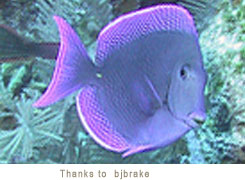 The Blue Tang is a popular and beautiful marine fish that drastically changes it's appearance as it becomes an adult. Young fish are yellow with blue rings around the eyes as they age, they develop blue lines and become blue with darker blue stripes on the fins. They can be quite aggressive as young fish but usually clam down with age.
The Blue Tang is a popular and beautiful marine fish that drastically changes it's appearance as it becomes an adult. Young fish are yellow with blue rings around the eyes as they age, they develop blue lines and become blue with darker blue stripes on the fins. They can be quite aggressive as young fish but usually clam down with age. It has a curious nature and grazes all around the tank.
They eat mainly algae and they are not recommended to be with invertebrates as the large eventual size of the fish will cause your small invertebrate to be turned into an easy snack!
Region: Western Atlantic
Maximum size: 6 inches in the aquarium grows up to 12 inches in the wild.
Powder Blue Surgeon
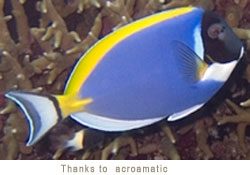 A very popular marine fish, however not best for beginners because it needs lots of space, excellent and consistent water conditions and a specific diet of vegetable based foods and can be picky eaters. Only one can be kept per aquarium as they are very aggressive and territorial against their own species. They get along peacefully with other species, provided they are not too small and can be eaten. The Powder Blue Surgeon is a bold and curious fish that grazes throughout the tank.
A very popular marine fish, however not best for beginners because it needs lots of space, excellent and consistent water conditions and a specific diet of vegetable based foods and can be picky eaters. Only one can be kept per aquarium as they are very aggressive and territorial against their own species. They get along peacefully with other species, provided they are not too small and can be eaten. The Powder Blue Surgeon is a bold and curious fish that grazes throughout the tank. Region: Indo-Pacific
Maximum size: 7 inches in the aquarium grows up to 10 inches in the wild.
Regal Tang
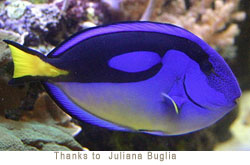 One of the most recognizable fish, make famous by Dory from Finding Nemo who was a Regal Tang. They are bold and beautiful with active movements and an entertaining agile, curious attitude. They are schooling fish in the wild, traveling with many others of the same species, however most hobbyists keep one per tank because they have a tendency to be aggressive towards each other in small spaces. Unless you have a massive tank, it is best advised to keep only one per tank. They are sociable with other species of saltwater fish. They require a diet of algae and vegetable matter.
One of the most recognizable fish, make famous by Dory from Finding Nemo who was a Regal Tang. They are bold and beautiful with active movements and an entertaining agile, curious attitude. They are schooling fish in the wild, traveling with many others of the same species, however most hobbyists keep one per tank because they have a tendency to be aggressive towards each other in small spaces. Unless you have a massive tank, it is best advised to keep only one per tank. They are sociable with other species of saltwater fish. They require a diet of algae and vegetable matter.Region: Indo-pacific
Maximum size: 6 inches in the aquarium grows up to 10 inches in the wild.
Yellow Tang
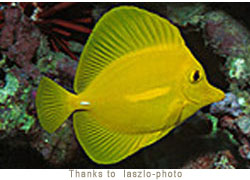 Vivid yellow fish is a beautiful addition to any saltwater aquarium, however their temperament can be unpredictable and terrestrial if they are not happy in their surrounding environment. They should not be kept together unless they are in a large school in a large tank. In the wild, they school in massive brilliant schools. They require lots of space and rocky terrain to graze in between the rocks and crevasses. The larger the tank, the more likely they will co exists with other species. They can be aggressive towards their own species and other species, so caution is required, provide lots of space and rocks to graze on, this will increase the chances of them living peacefully with other marine fish. They eat algae, their long snouts allow them to pick algae out of rocks.
Vivid yellow fish is a beautiful addition to any saltwater aquarium, however their temperament can be unpredictable and terrestrial if they are not happy in their surrounding environment. They should not be kept together unless they are in a large school in a large tank. In the wild, they school in massive brilliant schools. They require lots of space and rocky terrain to graze in between the rocks and crevasses. The larger the tank, the more likely they will co exists with other species. They can be aggressive towards their own species and other species, so caution is required, provide lots of space and rocks to graze on, this will increase the chances of them living peacefully with other marine fish. They eat algae, their long snouts allow them to pick algae out of rocks.Region: Pacific Ocean
Maximum size: 6 inches in the aquarium grows up to 9 inches in the wild.
Clown Trigger Fish
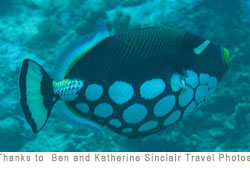 This fish is very sought after marine fish for it's stunning markings and impressive beauty. It is fairly difficult to keep because it grows very large and is very territorial. Do not keep the clown Trigger with smaller fish species. Do not place it in a reef tank or it will devour all invertebrates. It feeds on crustaceans like shrimp and squid. Beware of it's sharp teeth! It swims with agility and power and is a feature fish in any large aquarium. the young are not as vivid as adults. Complete with a curious personality, many triggerfish owners have been able to hand-feed their fish.
This fish is very sought after marine fish for it's stunning markings and impressive beauty. It is fairly difficult to keep because it grows very large and is very territorial. Do not keep the clown Trigger with smaller fish species. Do not place it in a reef tank or it will devour all invertebrates. It feeds on crustaceans like shrimp and squid. Beware of it's sharp teeth! It swims with agility and power and is a feature fish in any large aquarium. the young are not as vivid as adults. Complete with a curious personality, many triggerfish owners have been able to hand-feed their fish.Region: Indo-Pacific
Maximum size: 10 inches in the aquarium grows up to 20 inches in the wild.
Queen Triggerfish
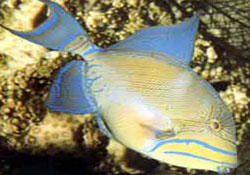 This fish is very elegant and beautiful with fine lines, it looks like a painting and has a long flowing tail that grows long at it ages. It is fairly difficult to keep because it grows very large and is very territorial with smaller fish and it's own kind. It can be peaceful with other large fish providing there is enough space in the tank for them to establish their own territories. Do not place the Queen Triggerfish in a reef tank or it will devour all invertebrates, do not place with smaller fish. It feeds on crustaceans like shrimp and squid. Beware of it's sharp teeth! It swims with agility and power and has a curious personality, many triggerfish owners have been able to hand-feed their fish.
This fish is very elegant and beautiful with fine lines, it looks like a painting and has a long flowing tail that grows long at it ages. It is fairly difficult to keep because it grows very large and is very territorial with smaller fish and it's own kind. It can be peaceful with other large fish providing there is enough space in the tank for them to establish their own territories. Do not place the Queen Triggerfish in a reef tank or it will devour all invertebrates, do not place with smaller fish. It feeds on crustaceans like shrimp and squid. Beware of it's sharp teeth! It swims with agility and power and has a curious personality, many triggerfish owners have been able to hand-feed their fish.Region: Western Atlantic
Maximum size: 10 inches in the aquarium grows up to 20 inches in the wild.
Threadfin Butterfly
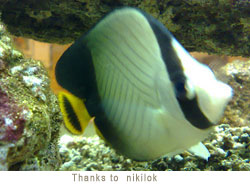 Beautiful but difficult to keep, the Threadfin butterfly requires consistent water conditions and a specific diet of live and frozen foods. They eat invertebrates and should not be kept with smaller fish or invertebrates that it will devour! Do not place in a reef tank. The are peaceful fish and get along well with other fish and members of their own kind. care should be taken however when introduction new fish as they can become too stressed from other fishes. They are shy so do not expect them to be swimming up front on display as they prefer to hide. They may be picky eaters and a variety if food is required for their well being.
Beautiful but difficult to keep, the Threadfin butterfly requires consistent water conditions and a specific diet of live and frozen foods. They eat invertebrates and should not be kept with smaller fish or invertebrates that it will devour! Do not place in a reef tank. The are peaceful fish and get along well with other fish and members of their own kind. care should be taken however when introduction new fish as they can become too stressed from other fishes. They are shy so do not expect them to be swimming up front on display as they prefer to hide. They may be picky eaters and a variety if food is required for their well being. Region: Indo-Pacific
Maximum size: 6 inches in the aquarium grows up to 8 inches in the wild.